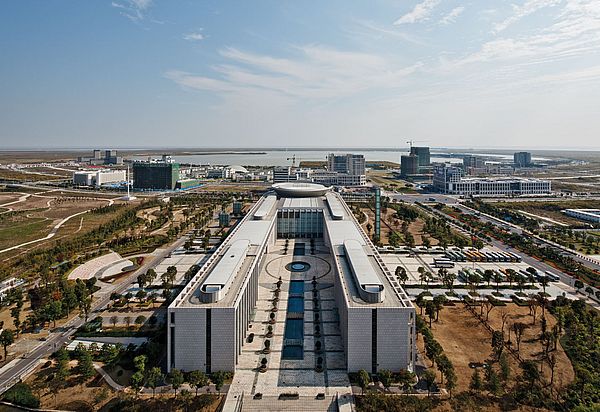A Citified World
Urban Strategies in the 21st Century
In this century of global mega-urbanisation, we see a repeat of the questions posed by city planners and architects a hundred years ago. But today’s challenges are greater—and considerably more complex. What do the solutions of the Bauhaus architects and early modernists have to say to today’s urban planners?
[Translate to English:] headline
The spirit of Walter Gropius, Hannes Meyer and Ludwig Mies van der Rohe floats over waters of Chile. Anyone looking today for similarities, lines of tradition, or affinities between the dawn of the 1920s and current architecture and city planning must travel far and wide. To Chile, for example. There, in the most European country in South America, the ideas of the Bauhaus fell on fertile ground early on. That is one reason why it is prob- ably not surprising that Alejandro Aravena is someone who has worked himself up in the world league of “starchitects” to become the one you would most likely trust to carry on the Bauhaus legacy. The 2016 Pritzker Prize Laureate does not build cubes, wrap-around ribbon windows or ac- cess galleries, however, the “half-houses” that brought him fame reflect something much more important: the readiness to throw traditions over- board, to blend functionality and design into radically new aesthetic responses, and not to forget that architecture and urban design are also a matter of social participation.

[Translate to English:] headline
Aravena is considered the “Robin Hood among architects” (Süddeutsche Zeitung). In 2003, despite having few subsidies to build housing for socially disadvantaged people, he refused to accept the idea of using a cookie-cutter approach to make cost-effective accommodations just to stay within the available budget. His approach: if I have only half the money needed to build a good house, why don’t I just build half a house but make it good? From this idea, a stunning concept evolved. People moved into the half-houses, and when they had saved enough money, they were able to enlarge and improve them, and in that way, each family gradually got an entire house of high quality. Mean- while, Aravena and his “do-tank”, Elemental, have built numerous such houses.
The best-known project was the reconstruction of the southern Chilean town of Constitución, which had been destroyed by the devastating 2010 earthquake and the subsequent tsunami. Elemental built entire settlements of half-houses. And because he poses not only aesthetic but also social and ecological questions, his responses differ greatly from what is generally heard in today’s field of urban design.
[Translate to English:] headline
The world is citified, that’s how one must see it now. Over 50 percent of people already live in urban regions, and according to UN calculations, by 2050 the figure will be two-thirds, making it about 6.3 billion. The political pressure put on newly developed economies to accommodate a growing population that is pushing into the cities from the countryside, and to do so in a reasonably humane way, appears overwhelming. Take India, for example, which is currently a hotspot of urbanization.

[Translate to English:] headline
Around two-thirds of India’s nearly 1.3 billion people still live in the countryside. But with every pass- ing minute, 25 to 30 people are moving from there into the city. According to official estimates, by the year 2050 the urban population will have doubled, reaching 800 million. That means India needs to build cities for about 400 million people by that time. That corresponds to the populations of the United States and Canada combined. Even today, nobody would contend that India’s cities are blessed with a perfect infrastructure. How will it look in 30 years?
The Indian government has resolved to actively shape the urbanisation process: 100 so-called smart cities are to be created in the com- ing years. These projects will only be of a limited scope, thought of as beacons that influence and inspire their surroundings. They are intended to show what urban design in the 21st century can look like: as an entrepreneurial project that procures private capital, manages private-public part- nerships, designs replicable urban models and employs digital technologies in order to be resource-efficient and sustainable. In just two years of planning, India has managed to identify most of the sites for this project.
American smart-city critic Adam Greenfield warns that these plans are destined to destroy the tradi- tional, organically evolved structures of India. “What may seem like the height of contemporary city-making in the government’s presentations and renderings is little more than a pretext to uproot poor farmers and fisher-people from the land, and replace their villages with gated enclaves and golf courses intended to serve the elite,” says Greenfield. His concern does not seem unwarranted, because the South Korean satellite city of Songdo provided the blueprint for India’s smart-city model. In Songdo at the beginning of the millennium, an internationally marketable prototype of the smart city was built on a large scale for the first time. But the enthusiasm remained limited. To this day, Songdo City is still considered sterile, soulless and a “ghetto for the rich” (Le Monde).
India now awaits what China has by and large already gone through. Since China’s eco- nomic reforms of the late 1970s, the country has undergone an urbanisation process unmatched in history. And there is no shortage of spectacular architecture. But urbanity? Quite a few new urban centres in China have been created entirely on the drawing board. Even German star architects were involved. The vast master plan by Gerkan, Marg and Partner (gmp) for Lingang New City, near Shanghai, looks at first like a copy of Ebenezer Howard’s classic Garden City. Until you realize its dimensions: 450,000 people will live there one day.
It is difficult to use European standards to measure what has emerged in China over the last decades. However, it seems natural to draw a comparison with the early 20th century. The Bauhaus, the New Building movement, and the great efforts made in housing development were not least a reaction to the rapid growth of big cities. “Of course, today the Bauhaus style is taught at Chinese universities,” says Austin Williams. The British author and lecturer has been studying China for years and has just published a book about eco-cities there, ti- tled “China’s Urban Revolution: Under- standing Chinese Eco-Cities”. “In practice, there are aesthetic borrowings here and there,” says the China expert, “but the great socialist thinking of the Bauhaus does not play a role in practice.” That is an assessment shared by local architects. “Endless building production has happened with little social responsibility,” explains James Shen, one of the founders of the People’s Architecture Office in Beijing. His office attracted attention as it expanded houses in historic districts by introducing modern “plug-ins” to upgrade the housing standard.
The question of how cities can be made viable for the future is important for people around the world. Because that is where decisions will be made about what economic development looks like, how sustainability works, and whether the community of nations is capable of reaching its climate goals.
“When I work with my students on visionary housing projects, we take the 1920s and 1930s as our model,” says Steffen de Rudder. The urban design professor from Bauhaus-Universität Weimar praises German housing from this time. “The great heroes are Ernst May and Bruno Taut,” says de Rudder. What Ernst May accomplished as the housing director in Frankfurt was impressive, getting things going under difficult conditions. And Taut’s famous Hufeisensiedlung (Horseshoe Estate) in Berlin was not just an aesthetic exclamation mark: “You would still like to live there today.”
Bruno Taut and Ernst May did not belong to the Bauhaus, but to the legendary group “Der Ring”, an architects association in the Weimar Republic. Walter Gropius and Ludwig Mies van der Rohe were also members, along with a large number of the people who are now associated with the New Building movement. In fact, the emergence of modernism in cities like Berlin, Frankfurt or Hamburg has left a lasting mark on the European understanding of good urbanity.
“That was the era of heroic modernism; it looks great. The housing estates are embellished with large inscriptions of the names of those who built them, because they were so proud in those days,” says de Rudder. And today? “What is being built now, you would not want to live there, would you?” asks the professor. The simplicity and boredom that is visible in large inner-city construction projects is astonishing. It is partly the result of a master plan that lacks crucial qualities, for example, in Hamburg, where the Altona-Mitte project only manages to achieve mediocrity.
Or it is the result of a visionlessbuilding mania, like that presently observed with ease in Berlin, for instance along the East Side Gallery, the longest extant stretch of the Berlin Wall. One cause of the German tristesse, however, can be found in traditional regulations, which con- tinue to perpetuate a functional separation of liv- ing and working. “That was sensible in an industri- al society plagued by emissions, but no longer,” says de Rudder. With the newly defined “urbane Gebiete” (urban areas), lawmakers have taken a step here in the right direction. The coexistence of residential, commercial, rear courtyards and social niches frequently produces the energy that vital places need. At least in Europe.
Architecture and urban planning, as proven by the past 100 years, can change the lives of people. For the worse, but also for the better. What answers would Gropius, Meyer or Mies—or Taut or May— give us today if they had to build for the 21st century? How would they deal with the problem of gentrification caused by obscenely expensive condominiums? What would they say about resilience and sustainability? How would they employ new technologies to make affordable housing possible? How would they increase density without causing social hot spots? Because whether in wealthy Europe or the rampant agglomerations of Asia and Africa, the “social question” presents itself in various forms every- where you look. Recognising that the design of buildings and cities can make a contribution to this issue is an integral part of the legacy of early modernism.
[TM 2017]


